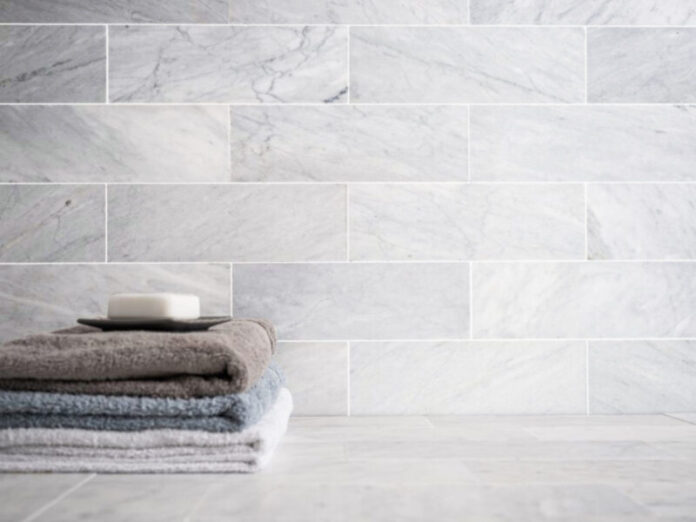Carrara Marble Tiles are the most popular type of marble tile in the world. They have a smooth, polished finish that is resistant to scratches and stains. This guide will teach you everything you need to know about these beautiful tiles.
Carrara marble is a type of limestone that is quarried in Italy. It has been used for centuries as a building material and also as an ornamental stone. The best carrara marble cleaner will help you keep your marble floor clean.
Carrara marble tiles may be the perfect choice for you if you’re searching for a luxury and timeless flooring solution.
Because it is so beautiful and durable, this kind of tile is often used in high-end houses and hotels all over the globe.
But how do they function? What are the finest cleaning methods? What should you bear in mind before you put them in place? Continue reading if these questions have perplexed you.
1. What is the difference between Carrara Marble Tiles and other marble tiles?
Carrara marble tiles are one of the most popular marble kinds for flooring and other uses.
Carrara, Italy’s quarries have been discovered to be 400 million years old, and its opal white stones are symbolic features in many magnificent mansions and houses throughout the globe.
It’s a kind of marble that’s known for its stunning beauty and may rightfully be described as a genuine piece of art.
These tiles are not only softer than stones, but they are also less porous, making them easier to clean than stone since dirt does not adhere to them as much.
Carrara marble offers the same hardness, durability, and workability as conventional materials while being more cost effective owing to its availability in blocks and slabs, which need less energy to cut when compared to granite.
2. How to Tell the Difference Between Real and Fake Carrara Marble Tiles
The tones in real Carrara tiles will range from deep white to light beige. The veins of real marble are noticeable but not prominent, and it is not too porous.
Real Carrara marble has a high sheen and is highly reflective of light, giving it a distinct and unique translucency that synthetic goods cannot match.
Synthetic goods are more likely to exhibit tone variations as brighter spots or dark patches on the surface, as well as streaks when moved over them. They don’t have genuine translucency or reflectivity, either.
Fake Carrara tile has an eerie similarity to genuine Carrara Marble owing to its firm surface (even if it wears out faster), but these characteristics may help you distinguish between the real and fake Carrara tiles.
Carrara Marble Tiles: How to Care for Them
An all-natural, non-toxic solution is the finest method to clean Carrara tiles. Simply combine water and a few drops of pure white vinegar in a spray bottle, then go to town on that ugly tile grout.
After thoroughly cleaning your tiles, dilute water with white vinegar with the diluted solution, spray the liquid over the tiles, wait 10 minutes, and then rinse it off.
You may do this in stages by spraying one area, letting it dry, and then moving on to the next. Try not to overlap while cleaning several spots, and don’t use soap!
Also, if possible, avoid using chemicals containing chlorine bleach since, although they clean the surrounding area very well, they harm the Carrara tile stone.
Also see: How to Keep Marble Floors Clean
4. Advantages and Disadvantages of Carrara Marble Tiles
Pro: It’s composed of limestone and gypsum ore, and it’s a natural substance. The size of the blocks is selected so that they may be installed without exerting too much force.
Carrara tile installation is also very simple, since all you have to do is stack the tiles one on top of the other.
Con: It is prone to etching or fading over time, and it has a staining propensity if not adequately protected against staining agents like oil-based paint and ink.
Cleaning may be challenging, particularly on highly textured surfaces where the buildup of dirt and grime can produce an uneven surface for clays and treatment solutions to adhere to during cleaning sessions.
5. Carrara Marble Tiles: Where to Buy and What You Should Know Before Buying

Marble buyers should always be sure they’re getting the real thing (a category that includes Carrara tiles).
Marble tiles may seem to be real stone, but if they are constructed of PVC, they are susceptible to chemical deterioration. Before making a choice, always examine the labels to see what materials the tiles were made of.
Thicknesses vary, but for flooring, thicknesses should be no more than 1/4′′ to prevent cracking and other durability problems, while for countertops, blocks may be up to 3′′ thick since they are not particularly flexible.
When choosing goods, keep in mind that the kind of cutting matters—polished corners will appear nicer than chipped or chopped tile.
Carrara tiles are easiest to get by at your neighborhood hardware shop. Because these shops should have everything in one place, it’s generally simple to locate what you’re searching for.
6. Before making a purchase decision, ask a flooring professional these questions.
To begin, you must choose the kind of flooring. Carrara tile is designed to withstand high foot activity and will outlast many other kinds of flooring. Second, inquire about the installation.
Is the service included in the price, or must you employ a contractor? How much would it set you back? Third, if at all feasible, inquire about warranties; how long do they last? What precisely does it cover? During this time, who can I contact if I have any problems?
Finally, inquire about cleaning supplies. Are they safe for the environment?
Carrara marble tiles are a type of stone that has been used in construction for centuries. They have a variety of uses, such as flooring and countertops. Reference: carrara marble tile floor.





